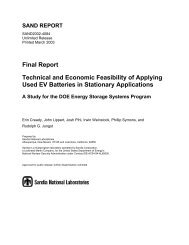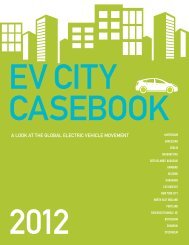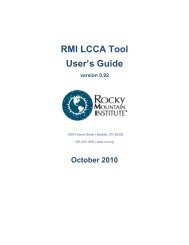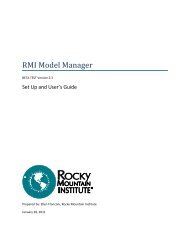Fleet Electrification Roadmap
Fleet Electrification Roadmap
Fleet Electrification Roadmap
- No tags were found...
You also want an ePaper? Increase the reach of your titles
YUMPU automatically turns print PDFs into web optimized ePapers that Google loves.
16 executive summaryPART FOURPolicy RecommendationsPRIMERThe <strong>Electrification</strong> Coalition has identified a suite ofpolicies to facilitate the adoption of grid-enabled vehiclesby fleet operators. These policies are intended tonarrowly address the specific obstacles to electric drivevehicle adoption that the Coalition identified in the<strong>Electrification</strong> <strong>Roadmap</strong>, adjusted to account for the specificchallenges faced by fleets. These policies, therefore,are intended to be consistent with the policies outlinedin the <strong>Electrification</strong> <strong>Roadmap</strong>, and to support the adoptionof electric drive vehicles in managed fleets. They arenot intended as a substitute for policies promoted by theoriginal <strong>Electrification</strong> <strong>Roadmap</strong>.<strong>Fleet</strong> Policy RecommendationsExpand the tax credits for light-duty grid-enabledvehicles purchased in deployment communities toinclude private sector fleets.Create tax credits for medium- and heavy-duty gridenabledvehicles deployed in fleets with greater than10 vehicles in operation.Create clean renewable energy bonds for fleet vehiclecharging infrastructure, and make municipal andregional transit authorities eligible for the bonds.<strong>Electrification</strong> of theTransportation Sector<strong>Fleet</strong> MicrosystemsIn many cases, fleets function as a microcosm of a transportationecosystem that could manage many—if notall—of the key elements of an electrification ecosystem/deployment community. For example, a fleet mightconsist of numerous vehicles that operate together in aconfined geographical space. This is certainly true formid-sized fleets that operate as part of geographicallyconstrained organizations such as a utility or city government.For national fleets, such as parcel delivery and telecomfleets, at least a subset of their vehicles frequentlyserve individual regions or urban areas. In addition, centrallyrefueled fleets provide refueling systems for theirvehicles at a home base or bases, allowing them to closelymanage the cost and reliability of energy infrastructureaccess. Finally, in the case of a fleet attached to large commercial,industrial, or government entity, the fleet operator(or its parent) will likely have a direct relationshipwith the local utility.The various types of financial support that wouldbe available to consumers and infrastructure providersin deployment communities should be available to fleetoperators, who may serve as a kind of electrificationmicro-ecosystem—or fleet microsystem. Like electrificationecosystems, GEV fleet microsystems offer theopportunity to accelerate the adoption of grid-enabledvehicles by promoting scale and cost reductions in batteryand vehicle production. While fleets ultimately representa smaller market than general personal use autos,the obstacles to their adoption of electric drive technologyare also smaller in some cases, and can be addressedby targeted public policies.Extend the existing tax credit for electric vehiclecharging infrastructure through 2018 and expand therange of eligible costs.Allow immediate expensing of GEV purchases andsupporting infrastructure for operators of certain fleets.Make tax credits for the purchase of qualifying grid-enabledvehicles and related charging infrastructure transferable.Incentivize the establishment of special purposeentities to facilitate bulk purchasing of electric drivevehicles by fleet operators.Other Policy RecommendationsReinstate and extend the credit for medium- and heavydutyhybrid electric vehicles that utilize advanced batteries.Establish a program to guarantee the residual value of thefirst generation of large-format automotive batteries putinto service between 2010 and 2013.Increase federal investment in advanced batteryresearch and development.Ensure that federal motor vehicle regulations do notunnecessarily prohibit the development and deploymentof cost-effective PHEVs in large trucks.Clarify the tax code to ensure that Section 30D GEV taxcredits are available to consumers who purchase a GEV(without a battery) and lease the battery from the dealer ora third party at the time the vehicle is purchased.
















